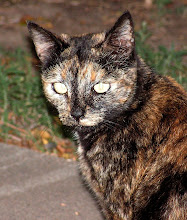We've all read or heard those horrid stories about the cat ladies and dog men who have lots of pet animals, the animals were half-starved, disease ridden, and several were dead. The first thing the officials on the scene say is, "The smell was so bad and there was animal feces a foot deep in places." That's the sign of a hoarder.
Feral cat colony management is completely the opposite. I have a friend who constantly asks me when do I have enough cats. I believe I'm at my limit now. Like with children, it's hard to spread attention on every cat when you've reached your limit. Colony management involves keeping track of who has been spayed/neutered and vaccinated. It means taking head counts several times a day to make sure all members of the colony have shown their faces at least once and you noticed that they have fed. In times of inclement weather, it means setting out extra food, devising the best possible shelters to help them stay warm, and warming up the food and water several times during the night.
Feral cat colony management means trapping sick or injured cats for veterinarian care and learning which simple illness you can treat from home. It's knowing the possible lineage of the cats in your colony. It's also knowing the medical history of each cat. With this many cats, I rely not on my memory, but my records. Feral colony managers usually keep records that include photographs of the cats they manage. Some cats managed to disappear when the camera is brought out, but colony managers strive to photograph every cat as they strive to spay/neuter ever cat in their colony.
Feral colony management also means trapping kittens born in the colony, socializing them, and placing them in permanent homes. If you've already read my previous posts, you will know that sometimes this just doesn't happen. Feral cat management also means being ready to make sacrifices when adoption and placement is not an option. It also means not taking in more cats than you have the physical, financial, mental resources for.
Most colony managers also ear-tip their cats. Ear-tipping is NOT disfiguring a cat. It's main purpose is to identify which cat has been spayed/neutered/vaccinated in the colony. If colony managers are also working their local animal control office, it let's the officers know that this cat is being managed and has been spayed/neutered/vaccinated and that the cat is not an ordinary feral. Because feral cats will not adapt to being tame pets, most animal control agencies immediately euthanize them.

MC sporting his ear-tip
Hoarders have complex mental health issues that spill in to the legal and municipal issues. Many towns and cities are conflicted in working with the best possible solutions of hoarders. One cannot spot a hoarder without visiting their homes. Hoarders can be anyone; police officers, veterinarians, vet techs, teachers, artists, plumbers, and store clerks have all been identified as hoarders.
The main signal of a hoarder is that they will not take their animals in for veterinarian care when they are sick. The second--and I've been accused of this one :D--is they will tell you that they rescued the animal from a fate worse than death or that this animal "needed them." This is actually very interesting because we all have that "need to be needed" gene inside of us. However, with someone who is also a hoarder, that gene is kicked up a thousand times stronger. It's the after care that lacking. Hoarders cannot say "No" when another animal is in need. They will bring that animal home, lavish it with all kinds of attention, until the next animal in need crosses their path. Then the previous animal is neglected while the care and attention is being thrust upon the newest animal.
So the next time you see someone and label them "The Crazy Cat Lady," look around. If you see kittens all the time or diseased animals or have a horrific odor emanating from next door, you might have a hoarder in your neighborhood. But if you noticed they have few kittens or that the cats are sporting ear-tips, then you know you have a colony manager who is being responsible.































Wow! What great information. You do hear about people with houses full of animals that don't care for them. Very sad and you know they can't be mentally fit. I don't have cats anymore, but your Java reminds me of a cat my son had at one time. So beautiful!
ReplyDeleteThanks Kathy! Java was very special to us. We lost her last August and I still hear her sometimes, asking to be fed. It's one of those things about feral colony management we learn is that we lose cats.
ReplyDelete